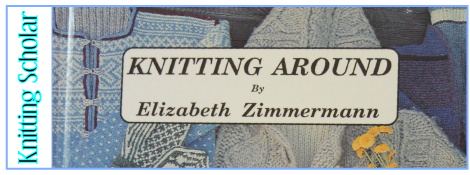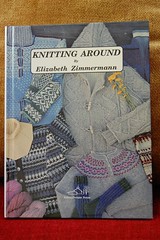First, the facts:
Title: Knitting Around
Author: Elizabeth Zimmermann
Published by: Schoolhouse Press, 1989
Pages: 191
Type: Design, stories, patterns, inspiration
Chapters:
1. Moccasin Socks and Other Stockings/(Digressions)
2. Fair Isle Yoke Sweater/(Digressions)
3. Knitted Dickeys & A Very Warm Hat/(Digressions)
4. The Knitted Moebius/(Digressions)
5. The Bog Jacket/(Digressions)
6. The Pie Are Square Shawl/(Digressions)
7. A Norwegian Pullover/(Digressions)
8. A Mittful of Mittens/(Digressions)
9. An Aran Coat/(Digressions)
Pattern Size Range: N/A
The In-Depth Look:
First, I need to reminisce a little. Back when I started knitting, I started off with two books. Maggie Righetti’s Knitting in Plain English (a great book on the basics), and this one. Twenty years later, I’m still thanking my lucky stars that I came across both of them when I did. Two very different books, but both written by strong women who encourage independent thought in knitting, rather than slavish, blind adherence to written patterns. Maggie Righetti’s was a fantastic “learn-to” book, but this one by Elizabeth Zimmermann?
Well, most knitters have heard of Elizabeth Zimmermann–and if you haven’t, you should get to your local library as quickly as your feet can take you to check her out. She’s the original knitting maverick, and the embodiment of a Thinking Knitter. She was the first writer to really talk about knitting as important in and of itself, rather than just a means to a nice little sweater. She encouraged people to try new things, to experiment, and above all, not to allow themselves to be restricted by what was written in a pattern. Trying to knit a sweater in a yarn you love but your gauge is different than the pattern? Adapt! Want to add in cables to the basic shape? Go ahead! Have a crazy idea in your head? Give it a try and see what happens! Not only that, she encouraged Continental-style knitting, and knitting in the round whenever possible–both of which are my preferred methods. (Largely, no doubt, because of these two books.)
So … about this actual book.
As I say, this was the second knitting book I ever bought, and it blew me away–especially as an introduction to one of knitting’s master original-thinkers.
There are two elements to this book, really.
First, there are the patterns. These, as you might expect, are NOT written for somebody who wants simply to be told “cast on 72 stitches, knit 27 rows, then…” No. These give you useful, solid numbers like that, but with frequent notes, like, “Gauge: 5.5 to 6 stitches to 1″, depending upon whether you are knitting for spindle-shanks or tree-trunk calves.” Because, you see, she assumes that you’re thinking about what you’re doing. (I love that.) She even has a sub-section in one pattern that reads, “Fudging: This is permitted, yea, even encouraged and necessary in knitting.”
Really, as written patterns go, these are very conversational. In fact, they’re practically written in real English, rather than in the standard “Knitters Abbreviation” language that we usually need to interpret. This alone makes EZ (as she’s known) helpful for a beginner who is still learning the language. The patterns are illustrated with black-and-white photos and sketches of stitches–no glossy, color photos.
But, you’re asking, what ARE the patterns? Are they easy? Hard? Complicated? Simple? The answer is … yes. They are all these things, just not necessarily all at once. One thing about Elizabeth Zimmerman, she didn’t believe in dumbing things down, and she believed that knitters are an intelligent bunch of people with a certain amount of instinct to help guide them. Knitting in the round just seems more logical than knitting flat pieces and sewing them together–so, there’s the Fair Isle Yoke Sweater. But if you wanted drop-shoulders, instead of a round yoke at the top? Try the Norwegian Pullover–and try steeking, too! What if we knit the entire bottom of a pair of socks, so that when they develop holes, we can just replace the worn soles and keep the rest of the original? Hello, Moccasin Socks. What if you just wanted to make a sweater out of big, garter-stitch squares with practically no shaping at all? There’s the Bog Jacket.
Oh, and the Pie-Are-Squared shawl? A take-off of her circular Pi-Shawl, but with squared off fronts? I lusted after that pattern for years. I wasn’t ready to tackle lace yet when I bought that book, but the pattern lurked in the back of my head for years before I finally made my own in 2005. It’s just such an ingenious pattern.
Well, that’s Elizabeth Zimmermann, for you. The woman who coined the name “I-Cord” for knitted cord, because it was So Simple an Idiot Could Do It. The woman who coined the phrase “Unvented” instead of using “invented” because she was sure her founding foremothers of knitting had surely thought of anything she came up with, it was just that the discoveries were lost in the mists of time. The woman who was so disappointed when one of her circular knitting patterns was rewritten by a magazine into a series of flat pieces, she published it herself in 1958 and started a knitting-publishing empire. (Okay, a small empire, but still–books, videos, yarn–all still being run in the family.)
Other than the patterns themselves–and the stories behind the patterns, and how to make the patterns, and what makes the patterns unique–this book tells the story of Elizabeth herself. These are her “Digressions” and are her reminiscences of her childhood in England, working in Germany, coming to America, buying an old Schoolhouse in Wisconsin … And this part of the book is just delightful. Warm and funny and charming.
Now, there’s some debate in knitting circles about whether EZ is “accessible” or “good” for a beginning knitter. Some beginners just don’t want to have to work this hard, or they want things spelled out for them because they’re just learning–they’ll figure out the theory part later. Or, they just don’t “get” it. Because, well, it’s true–Elizabeth Zimmermann started writing about knitting a long time ago–well before many of today’s newest knitters were born. It’s like looking through your grandmother’s old scrapbook of pictures rather than watching a cutting-edge video that just shows you want you need to know.
But, the thing is, if you just think of Elizabeth Zimmermann as an “old knitter,” and politely nod to acknowledge that she influenced a lot of the knitters you admire today … you’re missing the point. Don’t pre-judge because her illustrations are black-and-white, or because of her occasional strong opinions that you might disagree with (like the “never mix crochet with knitting” rule). Her patterns are still fresh and innovative. It’s just that they’ve been innovative for decades, so they don’t seem as fresh.
One argument I have heard is that she’s “boring.” But one thing that did occur to me the other day–I am a reader. I love to read, read all the time, been doing it for years. A book like this is pure gold for me because it’s informative, innovative, and entertaining all at once. BUT if you hate to read, I suppose I can see why you might not like this book. As much useful information is in here, there’s still a lot of digression and sidelines that might make you feel more frustrated than entertained–you know, if all you’re looking for is a “how-to” book.
And, that’s the other thing–as brilliant a EZ is at looking at knitting in a completely new way–she’s not really all that clear about her instructions for basic knitting techniques. (At least, not in print–the DVDs are great, though.) She explains the “why” better than she does the “how,” so don’t rely on this book to teach you HOW to knit. But, really, there are lots of books that do that. Elizabeth Zimmermann teaches you how to THINK.
Want to see bigger pictures? Click here.




Comments on this entry are closed.
One of my earliest knitting books was Knitting Without Tears and I feel very lucky about that!
Chris’s last blog post..The (more or less) bookish edition o’ links